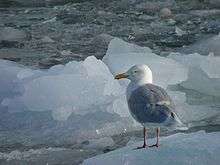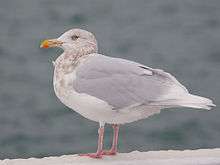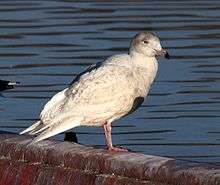Glaucous gull
| Glaucous gull | |
|---|---|
 | |
| Scientific classification | |
| Kingdom: | Animalia |
| Phylum: | Chordata |
| Class: | Aves |
| Order: | Charadriiformes |
| Family: | Laridae |
| Genus: | Larus |
| Species: | L. hyperboreus |
| Binomial name | |
| Larus hyperboreus Gunnerus, 1767 | |
The glaucous gull (Larus hyperboreus) is a large gull, the second largest gull in the world which breeds in Arctic regions of the Northern Hemisphere and winters south to shores of the Holarctic. The genus name is from Latin Larus which appears to have referred to a gull or other large seabird. The specific hyperboreus is Latin for "northern" from the Ancient Greek Huperboreoi people from the far north [2] "Glaucous" is from Latin glaucus and denotes a bluish-green or grey colour.[3]
This gull is migratory, wintering from in the North Atlantic and North Pacific oceans as far south as the British Isles and northernmost states of the United States, also on the Great Lakes. A few birds sometimes reach the southern USA and northern Mexico.
Description


This is a large and powerful gull, very pale in all plumages, with no black on either of the wings or the tail. Adults are pale grey above, with a thick yellow bill. Immatures are very pale grey with a pink and black bill. This species is considerably larger, bulkier and thicker-billed than the similar Iceland gull, and can sometimes equal the size of the great black-backed gull, the largest gull species. They can weigh anywhere from 960 to 2,700 g (2.12 to 5.95 lb), averaging 1.55 kg (3.4 lb) in males and 1.35 kg (3.0 lb) in females.[4][5] At the colony on Coats Island in Canada, the gulls are nearly 15% heavier than other known populations, with a mean weight 1.86 kg (4.1 lb) in males and 1.49 kg (3.3 lb) in females. Thus, Coats Island glaucous gulls are about the same weight as great black-backed gulls or even marginally heavier and their maximum weight is greater.[6] These gulls range from 55 to 77 cm (22 to 30 in) in length and can span 132 to 170 cm (52 to 67 in) across the wings.[5][7][8] Among standard measurements, the wing chord is 40.8 to 50.1 cm (16.1 to 19.7 in), the bill is 4.9 to 6.9 cm (1.9 to 2.7 in) and the tarsus is 6 to 7.7 cm (2.4 to 3.0 in).[5] They take four years to reach maturity.
The call is a "laughing" cry similar to that of the herring gull but deeper.
Subspecies
There are four subspecies:
- L. h. hyperboreus, Gunnerus, 1767: nominate, found from northern Europe to north-western Siberia
- L. h. pallidissimus, Portenko, 1939: found from north-western Siberia to the Bering Sea
- L. h. barrovianus, Ridgway, 1886: found from Alaska to north-west Canada
- L. h. leuceretes, Schleep, 1819: found from north-central Canada to Greenland and Iceland
Ecology
This species breeds colonially or singly on coasts and cliffs, making a lined nest on the ground or cliff. Normally 2–4 light brown eggs with dark chocolate splotches are laid.
These are omnivores like most Larus gulls, and they will eat fish, insects, molluscs, starfish, offal, scraps, eggs, small birds, small mammals and carrion as well as seeds, berries and grains.
 Glaucous gull at De Cocksdorp, Netherlands
Glaucous gull at De Cocksdorp, Netherlands
- Egg, Collection Museum Wiesbaden

References
- ↑ BirdLife International (2015). "Larus hyperboreus". IUCN Red List of Threatened Species. IUCN. 2015: e.T22694343A85048979. Retrieved 4 May 2016.
- ↑ Jobling, James A (2010). The Helm Dictionary of Scientific Bird Names. London: Christopher Helm. pp. 198, 219. ISBN 978-1-4081-2501-4.
- ↑ "Glaucous". Oxford English Dictionary (3rd ed.). Oxford University Press. September 2005. (Subscription or UK public library membership required.)
- ↑ Dunning Jr., John B., ed. (1992). CRC Handbook of Avian Body Masses. CRC Press. ISBN 978-0-8493-4258-5.
- 1 2 3 Olsen, Klaus Malling; Larsson, Hans (2004). Gulls of North America, Europe, and Asia. Princeton University Press. ISBN 978-0691119977.
- ↑ Dunning Jr., John B., ed. (2008). CRC Handbook of Avian Body Masses (2nd ed.). CRC Press. ISBN 978-1-4200-6444-5.
- ↑ "Glaucous Gull". All About Birds. Cornell Lab of Ornithology. (2011)
- ↑ Harrison, Peter (1991). Seabirds: An Identification Guide. Houghton Mifflin Harcourt. ISBN 978-0-395-60291-1.
External links
| Wikimedia Commons has media related to Larus hyperboreus. |
| Wikispecies has information related to: Larus hyperboreus |
- Glaucous gull, Alaska Seabird Information Series
- BirdLife species factsheet for Larus hyperboreus
- "Larus hyperboreus". Avibase.

- "Glaucous gull media". Internet Bird Collection.
- Glaucous gull photo gallery at VIREO (Drexel University)
- Interactive range map of Larus hyperboreus at IUCN Red List maps
- Audio recordings of Glaucous gull on Xeno-canto.
- Larus hyperboreus in the Flickr: Field Guide Birds of the World
